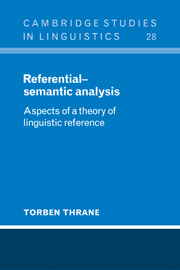Book contents
- Frontmatter
- Contents
- Preface
- Introduction: The functions of language
- PART I THE PRELIMINARIES
- PART II THE THEORY
- 3 SOME FUNDAMENTAL NOTIONS
- 4 THE BASIS OF RS-ANALYSIS
- 5 REFERENTIAL–SEMANTIC FEATURES
- 6 SUBJUNCTION AND ADJUNCTION
- PART III THE APPLICATION
- CONCLUSION: SUMMARY AND FURTHER PROSPECTS
- Bibliography
- Index
6 - SUBJUNCTION AND ADJUNCTION
Published online by Cambridge University Press: 06 August 2010
- Frontmatter
- Contents
- Preface
- Introduction: The functions of language
- PART I THE PRELIMINARIES
- PART II THE THEORY
- 3 SOME FUNDAMENTAL NOTIONS
- 4 THE BASIS OF RS-ANALYSIS
- 5 REFERENTIAL–SEMANTIC FEATURES
- 6 SUBJUNCTION AND ADJUNCTION
- PART III THE APPLICATION
- CONCLUSION: SUMMARY AND FURTHER PROSPECTS
- Bibliography
- Index
Summary
Serialization
If (5: 30) is a reasonable means for determining the deep structure properties of all those five pretty girls, we obviously need a set of rules that will ensure that the items constituting the terminal string appear in correct surface order. Whereas conventional transformational rules may not only change the order of the categories referred to in the structural index of a given T-rule, but may also add and delete material (not) generated by the phrase structure rules, the question of sequence for our purposes seems to have top priority, although obviously some form of deletion is required to account for e.g. kind and some in (5: 31). This matter, however, is linked with the question of serialization.
The surface order of the elements in an English NP allows a certain amount of fluctuation within a stable, basic scheme, a fluctuation which to a large extent is due to the possibility of a number of adjectival modifiers occurring with the same noun (cf. e.g. Goyvaerts 1968; Sussex 1974), and also to a number of idiosyncratic properties of certain quantifiers, notably all.
However, the rules we need to transform a terminal string like that in (5: 30) into an acceptable surface string all conform to the basic principle of subjunction.
Subjunction
The term ‘subjunction’ – and its ally, ‘adjunction’ – in the sense in which it is to be taken here, is introduced by Anderson (1971c) and further developed by him in subsequent works, notably (1977: ch. 2).
- Type
- Chapter
- Information
- Referential-Semantic AnalysisAspects of a Theory of Linguistic Reference, pp. 102 - 122Publisher: Cambridge University PressPrint publication year: 1980



